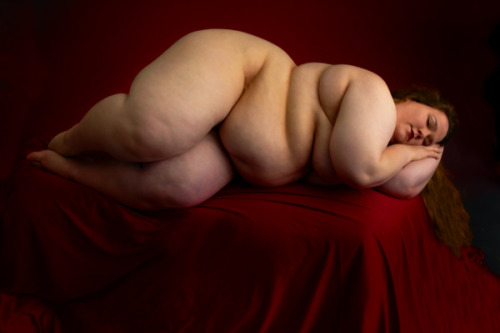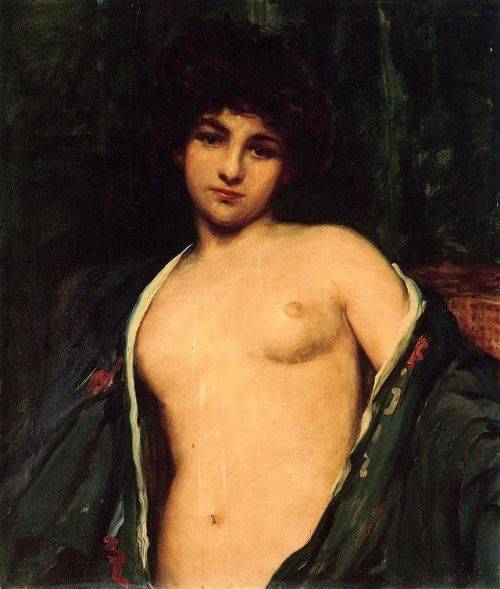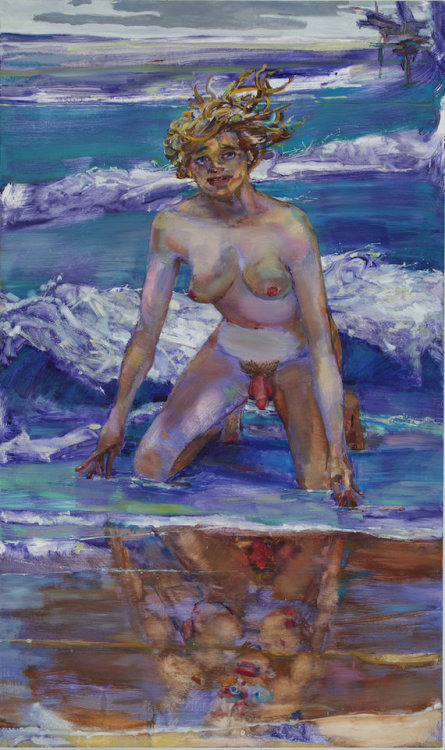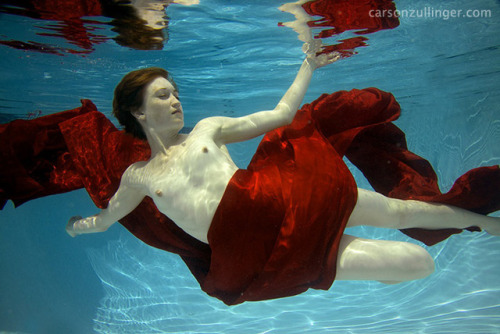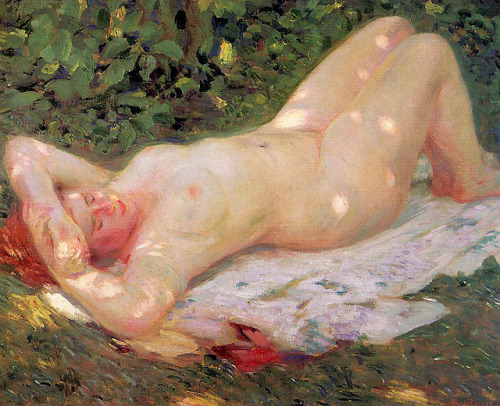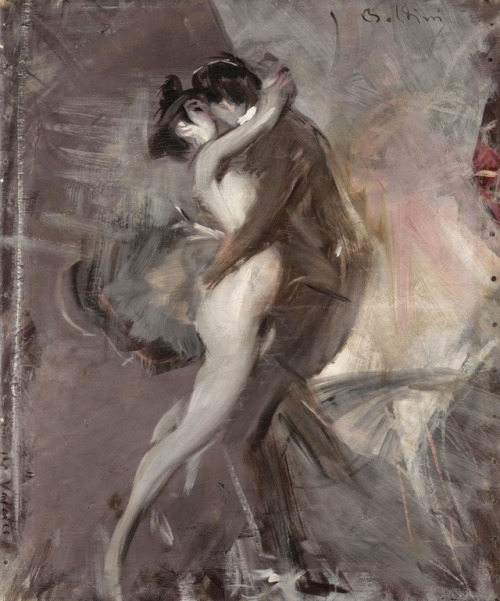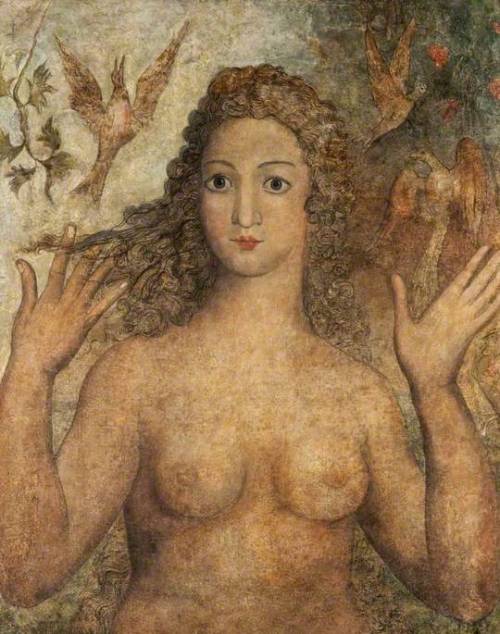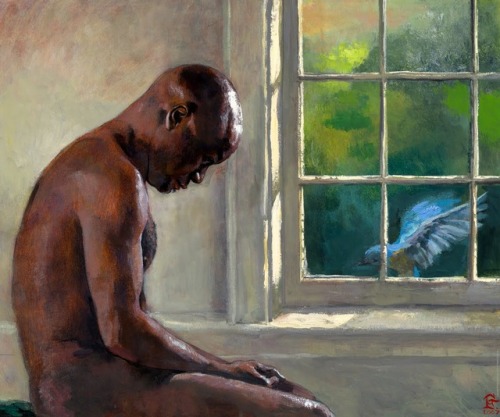#casey lorne
Two Against the World by Ernst Ludwig Kirchner, 1924.
Dystopian authors such as Aldous Huxley and George Orwell proposed that the greatest threat to a totalitarian system would be romantic love.
In Brave New World, children are inculcated with the belief that all bodies belong to everyone. Sex is not allowed to be a form of intimacy. Instead, it serves as a means for reinforcing the prevailing social order.
For the same reason, sex is repressed in Orwell’s 1984: relationships create private loyalties, which ferment rebellion and weaken loyalties to the state.
Conflict frequently turns up as a theme in Kirchner’s paintings. Sometimes he depicts inner struggles while, in other works, his interest is a perceived battle between personal freedom and a staid, suffocating environment.
For Kirchner, there is already a totalitarianism of conformity lurking underneath the veneer of western civilization. Creators and lovers have to be against the world to survive in this hostile society.
How would Kirchner fit in a state controlled by national socialists? Well, you can guess the answer.
In 1933, the Nazis branded his art as degenerate. In 1937, they destroyed or sold off 600 his paintings.
In 1938, Kirchner died in front of his house from a self-inflicted gunshot wound. He was 58.
Post link
Boteroesque by James Hickey, 2005
The model, Miss Shyly, participated in Leonard Nimoy’s book, The Full Body Project.
Post link
Portrait of Evelyn Nesbitt by James Carroll Beckwith, c. 1901.
(Trigger warning: sexual assault)
The most famous character in English Canadian literature is Anne Shirley.
In a series of books written by Lucy Maud Montgomery, Anne arrives on Prince Edward Island as an orphan to be put to work on a farm owned by siblings Matthew and Marilla Cuthbert. The pair had expected to welcome a boy, but Anne manages to charm her hosts and subsequently embarks on a series of mischievous but endearing adventures.
Originally published in 1908, Anne of Green Gables, the first of six novels with her name in the title, has sold more than 50 million copies worldwide. In Japan, Anne is a cult figure: every year thousands of tourists, some with marriage plans, make the pilgrimage to Cavendish, where Montgomery set and wrote most of her stories.
Adaptations of Anne of Green Gables, for stage, screen and television, in formats ranging from musicals to anime, are so numerous that compiling a complete list may no longer be possible. The book has been dramatized as a radio play in Slovakia and as a vlog in Finland. From school plays to a Netflix miniseries, thousands of girls around the world have played Anne Shirley.
Even Anne Shirley has played Anne Shirley. Dawn O’Day, while starring in a 1934 movie version of Anne of Green Gables, was so taken with the character that she adopted the name as her own.
Anne Shirley was nominated for an Academy Award for Best Support Actress in 1937. Anne Shirley has a star on the Hollywood Walk of Fame.
When starting the novel, Montgomery was inspired by a picture of a beautiful New York model, Evelyn Nesbit, which she’d clipped from a magazine. In the author’s imagination, the supposed ingenue was a symbol of “youthful idealism and spirituality.” She pasted the picture to her bedroom wall and used it as the guide for creating her title character.
Montgomery turned her sense of who Evelyn Nesbit was into Anne Shirley.
Nesbit wasn’t quite an orphan: her father had died in 1895 when she was 11, leaving his widow and children destitute. School could not be an option in such desperate circumstances. Three years later, Nesbit was working 12-hour days, six days per week, at Wanamaker’s department store. So was her mother. So was her younger brother, who had just turned 12
One day a customer, struck by Nesbit’s beauty, asked permission to paint her portrait, offering $1 for five hours of work. More requests followed, each artist more famous than the last. Within a few months, Nesbit was on a path to becoming America’s first celebrity supermodel. Harper’s Baazar, Ladies’ Home Journal, Cosmopolitan and Vanity Fair all featured her face on their covers.
Music hall managers vied to put Nesbit on the stage, knowing fans would come to ogle her and not care if she could sing or act. Rich bachelors, hoping their inheritances might lure Nesbit into marriage, made the biggest fuss.
The first one to rape her was Stanford White, a 47-year-old architect who had ingratiated himself with Nesbit’s mother and persuaded her to go to Pittsburgh for a respite–leaving him, effectively, in the position of guardian. He plied his temporary ward with champagne, likely laced with a tranquilizer, and used her body while she lay incapacitated.
The next rapist was Henry Kendall Thaw, the son of a coal and railroad baron, who claimed to have watched 40 performances of Nesbit’s show. As part of his courtship, he accompanied the Nesbits on a tour of Europe. Following White’s example, Thaw was able to persuade the mother that her daughter could be left in his care, without a chaperone. He proposed marriage while the duo were in Paris. When Nesbit declined, the heir to a $40-million fortune demanded to know the reason why he was being rejected. Eventually he wore Nesbit down and she confessed that White had stolen her virginity. Made impure by that encounter, she knew she would not make a suitable wife for a man from a prominent conservative family.
Thaw took Nesbit to several shrines devoted to virgin martyrs before they headed for an isolated Austrian castle he’d rented near the top of a mountain. There, he locked her in a room and tortured her for two weeks, using a whip to beat her in between sexual assaults.
One morning, having released all his temper and (in his mind) purified his potential bride, Thaw, in an upbeat mood, came to Nesbit and liberated her from the castle prison. He apologized for being rough and insisted they finish their European tour.
A “fallen” woman in that era had few options. To protect her reputation, Nesbit married Thaw on April 4th, 1905. She did get him to promise to behave like a “Benedictine monk.” In turn, Thaw assured his bride she was forgiven for what she had done with White.
Thaw took his monastic pledge seriously. He forbade Nesbit from discussing her previous work and confined her to the supervision of his sanctimonious mother. Meanwhile, he became a crusader against moral turpitude, sharing strategies with Anthony Comstock on how to eradicate vice.
(Prior to his marriage, Thaw had frequented bordellos, injecting himself with cocaine and morphine to augment his sexual experiences.)
Paranoia soon set in and Thaw became convinced that minions of sin were targeting him for assassination. He presumed that Stanford White must be their leader. Thaw started carrying a gun with him wherever he went.
On June 26th, 1906, both men attended a performance at the rooftop stage above Madison Square Gardens. During the finale, Thaw drew his pistol, approached his antagonist and fired three bullets from a distance of two feet. According to police reports, the attack left White’s face shredded to the point it was no longer recognizable.
Thaw stood over the dead man and shouted, “I did it because he ruined my wife!”
Although the district attorney was willing to accept a plea of clinical insanity, Thaw’s mother thought that result would besmirch the family name, She spent $500,000 on doctors who testified Thaw had suffered from a temporary “brain storm.“
It took two trials but the strategy worked. Jurors concurred that Thaw was insane at the time of the murder but would eventually recover. After a seven-year stay (aside from a brief escape to Canada) in an asylum essentially turned into a luxury residence, Thaw received the all-clear from the courts and resumed his playboy ways, newly divorced from his wife.
Of course, the person really being judged during the trials was Nesbit, She had to admit on the witness stand that White, technically, had been her lover. The yellow press sold newspapers with lurid headlines: “Woman Whose Beauty Spelled Death and Ruin,” for example. It took only a week after White’s death for Thomas Edison to complete a film, Rooftop Murder, which played at the nickelodeons.
A red velvet swing came to symbolize the tragedy. It hung from the ceiling of Stanford White’s residence. Before the rapes, before the murder, before the journalists, Nesbit would climb on to it and ask White to push her, higher and higher and higher.
After the verdict, Thaw’s family stopped paying Nesbit’s allowance. Returning to show business, she was able to overcome her notoriety to perform in vaudeville and silent movies. The popularity she’d enjoyed, however, would never return.
During Prohibition, she operated a New York speakeasy. Alcoholism contributed to a suicide attempt in 1926.
She worked in burlesque for a while and taught sculpting and ceramics.
Her last venture into the public eye came in 1955, when Twentieth Century Fox released a highly-fictionalized account of the rivalry between Thaw and White. Called The Girl in the Red Velvet Swing, Marilyn Monroe was tapped to play Nesbit but expressed disinterest. The part went to Joan Collins.
Nesbit made $10,000 working for the producers as a technical consultant.
She died in a California nursing home in 1967, age 82, not knowing there was another version of her life, that in a different story she had red hair, lived on an idyllic island farm and only struggled with alcohol that one time she confused current wine for raspberry cordial.
Had she known the picture that inspired her was of “that Nesbit girl,” Montgomery wouldn’t have pasted it on her bedroom wall. She wouldn’t have interpreted it as a representation of “youthful idealism and spirituality.”
But, unaware of the scandalous connection, she could see what she wanted to see.
Perhaps any photograph, especially out of context, shows us what we want to see. It occurs to me that all art may be like that–equally capable of telling great truths and pernicious lies. Whatever the intention of the creator, the audience ultimately determines the meaning.
Like Montgomery, when I came across Beckwith’s painting, I thought I’d found a depiction of innocence and purity. Now that I’ve learned Nesbit’s story and know what is going to happen to her, I look into those dark eyes on the canvass and see unrelenting sadness.
Post link
Male Nude, Draped by John Singer Sargent, c. 1900.
Sargent (1856-1925) exhibited very few works with overtly sensual themes during his career. He did, however, keep an album of private drawings of nude men. The images were not highly regarded by the Harvard museum which received them as a bequest from Sargent’s family. Scholar Trevor Fairbrother “rediscovered” the albums in 1981, though some of the drawings would remain unpublished for another 20 years.
A sense that someone’s art has homoerotic qualities is not by itself proof of sexual orientation. Sargent never married. He had long-term friendships with men or women. He was a private person whose letters and personal reflections were destroyed shortly after his death.
Although most people seem to have preferences among genders (male, female and more) when seeking partners, I hope that doesn’t preclude an ability to see sensuality outside of orientation. Tumblr blogs which feature versions of the same kind of body (usually white and skinny) over and over again disinterest me (and I dislike the reinforcement of stereotypes) but I also feel a kind of pity for anyone who has such a narrow view of beauty. What if you only liked one kind of food? Lasagna is a marvel but I’d get tired of eating it every night.
Returning to Sargent, if he made great apple pies but preferred to eat carrot cake, does that make either dessert any less scrumptious?
Post link
Photographers Alana and India kissing and cuddling in an image they took for the website ishotmyself.com. It was posted to a free gallery.
Post link
BryanabyDoug Winsor, 2009.
On his Model Mayhem page, Winsor, who is based in Nova Scotia, notes he’s “always looking for serious models… who want to jump around naked for me.”
His books may be purchased here.
Post link
Froath Diva by Angela Dufresne, 2015.
Deft in techniques of revision, erasure, overlay and addition, Dufresne deploys empathy and humor with equal parts skill and sensitivity in a commitment to painting’s ability to present, transgress and reconfigure experience and representation.
- Guggenheim Fellowship citation
(Source)
Post link
Canadian spring 2017. Flowers, bears and sun deprived pale flesh. Walking with @exposureme
© Milo Dlouhy
The second of a pair of beautiful pictures I’d set aside to reblog on a dreary day, hoping a reminder of golden spring light would provide an infusion of inner warmth.
Post link
Ladies’ Night (Ivor Dickie) by Beryl Cook, 1981.
I don’t know how my pictures happen, they just do. They exist, but for the life of me I can’t explain them.
(Source)
Post link
(Trigger warnings: racism and slavery.)
Brown Girl After the Bath by Archibald John Motley, 1931.
Motley was the first African-American artist to earn a Guggenheim Fellowship for his artistic prowess and the first to be given his own show at a New York gallery. Despite this pioneering, his personal attitudes toward race were inconsistent and often troubling.
In an interview for the Archives of American Art recorded in the late 1970s, he recalls his grandmother’s experiences as a slave:
She said they treated her just lovely. She got nice clothes, nice shoes. They made them take good care of themselves. They made them bathe. They had good food to eat; they had the same kind of food as the master and the family had. So she said it wasn’t difficult at all. She said she liked it. She loved her master and mistress.
How does Motley miss the paternalism and infantilization at the core of that recollection? In one of his paintings, in gratitude to his grandmother’s owners, Motley actually added an image of the mistress as a tribute.
Motley does acknowledge that not everyone had the same experiences of slavery, but overall he seems to downplay the impact of racism on African-Americans, even hinting that inequality is partly self-inflicted. His rationalizations are difficult to hear, especially from someone whose breaking of barriers helped make the Harlem Renaissance possible.
His art, however, leans toward the progressive, with Motley demonstrating a moral obligation to uplift African-Americans through positive representations. Often he was preoccupied with skin tone, bringing to the forefront values of diversity and self-determination. In part, this was to subvert stereotypes. He wanted white audiences to appreciate the individuation within ethnic minority communities. Of the people in his paintings, he said:
They are not all the same color. They’re not all black. They’re not all, as they used to say years ago, high yellow. They’re not all brown. I try to give each one of them character as individuals…
Two of his most famous works, Octoroon Girl and the Mulatress, embed this message of diversity within their titles–though Motley’s terminology sounds like fingernails scraping a chalkboard from a 21st century listening post.
The description of the bather in the selected painting as “brown” is easier on the ears. Motley is very respectful of his nude figure. There’s an open curtain, an invitation to look, which mitigates the sense of voyeurism. Her confidence makes her more subject than object, and she is staring back at us, affirming her humanity, asserting her beauty as a person–which Motley, through his attention to detail, shows is enhanced, not mitigated, by the brown hue of her skin.
Post link
FromLine of Beauty (series) by Carson Zullinger, 2014.
My artwork derives from the exploration of the inner self, and its contrast with the physical world. I use dreams and the subconscious as a starting place to envision new imagery. I strive to create pieces that incorporate a sense of spirit or mind-body interrelationship, and at the same time tell a story.
(Source)
Post link
You came to me this morning
And treated me like meat.
You’d have to live alone to know
How good this feels, how sweet.
My mirror twin, my next of kin,
I’d know you in my sleep.
And who but you would take me in
A thousand kisses deep?
All soaked in sex, and pressed against
The limits of the sea;
I saw there were no oceans left
For scavengers like me.
We made it to the forward deck.
I blessed our remnant fleet–
And then consented to be wrecked
A thousand kisses deep.
- Leonard Cohen, For Those That Greeted Me (excerpts)
(I couldn’t find a credit for the photographer.)
Post link
Sunspots by Lawton Parker, c. 1912.
In the spring, in the time before the massacre, the faithful made the great pilgrimage to Giverny, where the Seine meets the Epte River, to praise the flowers and worship the light.
It was Claude Monet who had seen this land of promise, from his railway car in 1883, when the Belle Epoque was too green to have a name. He built his settlement in Giverny, dreaming into the world his jardin remarquable of brick walls adorned with blooming vines and tulips in their thousands planted in carefully cultivated rows.
A decade later, emboldened by sales of his paintings, Monet bought vacant land across the road and baptized it as a pond by diverting a tributary of the Epte. It was there he cultivated his water lilies and mingled art into nature, nature into art.
Lawton Parker’s first pilgrimage to Giverny may have been in 1903, when he was 35, but it was later than that, when the Belle Epoque seemed immortal, that this American disciple worshiped at the shrine with all his heart. He witnessed the light as it made gold of the green leaves and marveled at how it danced across the surface of warm skin, unclothed, the innocence of the human form.
What sin of man could be so horrific as to sink this Eden to grief?
When the massacre started Parker returned to Chicago, where he’d kept a home since 1901. He hosted salons, taught young artists. He continued to win prizes for his paintings, but they also brought scandal: luminous nude bodies, sun-dappled and shameless–in a fallen world, they were emblems of vice. Conservative museums, including the Art Institute, refused to display his work. Parker left for New York in 1916.
On the canvass, he always retained his impressionist devotions, but war ruptured the conjoining of nature and art, leaving an incurable wound, bloody, pus-filled and gangrene.
Parker faded as the light at the end of the day. The chaos of expressionism, modernism and surrealism provided no sanctuary for a person of faith.
He was just another old guy who’d retired to Pasadena when his heart stopped beating in 1954.
They were pipes of pagan mirth,
And the world had found new terms of worth.
He laid him down on the sun-burned earth
And raveled a flower and looked away–
Play? Play?–What should he play?
- Robert Frost
Post link
Jake Gyllenhaal and Heath Ledger jump into the Bow River, east of Canmore, Alberta, in a scene from Brokeback Mountain (Ang Lee, 2005).
Post link
The Couple by Giovanni Boldini, 1905.
Perhaps because he was so good at portraiture, Boldini (1842-1931) didn’t fully explore his artistic imagination. Often he is brushed aside by critics because he was mainly a genre painter, someone who settled for money instead of seeking true genius.
He could bring emotion to the canvass. His output, however, contains few pieces as joyfully creative as this one.
Post link
Eve Naming the Birds by William Blake, 1810.
Open marriage, sexual equality, gratification, free love: these are the Christian virtues that inspired William Blake (1757-1827).
Critics in his own time called him a lunatic, for his non-conformity and his visions, which included appearances by angels. Blake, in turn, thought he lived in a mad world, How else to explain the tendencies toward violence, cruelty, selfishness and repressive morality?
He was an engraver by profession and very accomplished. Someone who knew him as a young man might have assumed his fame would come from his art, not his poems. He was prolific in his writing, but his talent with words wasn’t appreciated by most of his contemporaries. Blake is read today because future generations of scholars rediscovered him. In his own time he was a silly eccentric, mostly harmless, though his radical political and religious views were cause enough for a charge of high treason. (He was acquitted.)
The rehabilitation of Blake is demonstrated in the idiosyncrasy that one of his poems (with music added by Hubert Parry in 1916) has become England’s unofficial national anthem. God Save the Queen is sung to represent the United Kingdom as a whole, but at events where athletes compete under St. George’s Cross (not the Union Jack), And Did Those Feet in Ancient Time plays in the background when England wins a gold medal (for example, at the Commonwealth Games.)

The poem, seen above as Blake originally published it, includes the biblical image of the Chariot of Fire, which was modified to become the name of the 1982 Oscar winner for Best Picture. Its rhyming partner, however, is a more interesting line: “Bring me my Arrows of desire.” For Blake, the liberation of sex from morality and the triumph of the imagination were preconditions for England becoming a new Jerusalem–essentially, heaven on earth.
Parry composed the music during World War I at the behest of a militarist group. Almost immediately, he had misgivings. In 1788, Blake had written a poetic essay with the title, All Religions Are One. On another occasion, he asserted “all men are alike (tho’ infinitely various.“) The poet would have been horrified by the slaughter in the trenches. When the song started to become popular, Parry gifted the rights to the National Union of Women’s Suffrage Societies in early 1918. Blake admired Mary Wollstonecraft, author of A Vindication of the Rights of Women, so he probably would have been pleased with that outcome.
Though he advocated for sexual freedom, Blake was happily married to his wife Catherine for 35 years and by all accounts they were monogamous–though he did ask if she could be persuaded to try a threesome.
(Additional source: English Romantic Writers, ed. David Perkins.)
Post link
Blue Bird by Philip Gladstone, 2005.
They are naked because they are lonely, confused, solitary–and they engage, indulge and shudder in being solitary, confused and lonely because they are naked.
Post link
“Subversive as Hell.”
That’s how Theodor Geisel described his books. He wrote to teach children about literacy but also infused his rhyming couplets with political allegory.
The star-bellied Sneetches and their plain-bellied counterparts learn an expensive lesson about the folly of racism. The tragic consequences of consumerism are witnessed by the Lorax, champion of the trees. When he learns that material wealth does not guarantee love, the Grinch’s heart grows three sizes.
(It’s a wonderful irony that Geisel gained the economic comfort to become an author by designing advertising campaigns–for Standard Oil.)
Geisel’s first best-selling story, And to Think that I Saw it on Mulberry Street, celebrates cultural diversity. Two years later, in 1939, he wrote his biggest commercial fiasco, also a book with a cause: the liberating potential of nudism.
Though illustrated as a children’s book, The Seven Lady Godivas: The true facts, at last, about history’s barest family, was written for an adult audience. Random House lacked enthusiasm for the project but had to publish it–the price paid for persuading Geisel to defect from Vanguard Press was acceptance of the manuscript.
The story, written in prose, begins with the Godiva sisters mourning the death of their father in a riding accident. They vow not to marry until they’ve all completed quests, in the picaresque tradition, warning people about the dangers of horses.
None of the seven ever wears a stitch of clothing because, “They were simply themselves and chose not to disguise it.” From fat to thin, tall to small, each sister has her own form and shape.


Dr. Seuss (an alias derived from Geisel’s middle name and his mother’s maiden name) anticipated the body positive movement — but he was a few decades too early. When the book didn’t sell in stores, Random House tried to move them at cigar stands at a discount of more than 80 per cent.
The setback caused Geisel to take a leave of absence from writing. A fierce opponent of fascism, he became a political cartoonist for a left-learning New York newspaper opposed to isolationism. When America entered the conflict against the Axis forces, Geisel joined the military as a propagandist. He was assigned the rank of captain and made commander of the First Motion Picture Unit of the United States Army Air Forces. He produced work so effective he earned the Legion of Merit.
(During this period, he supported the internment of American citizens of Japanese descent. Written in 1955, Horton Hears a Who, about an elephant who defends a microscopic world recovering from a disaster, is interpreted by some scholars as an apology.)
Later in life, Geisel lamented The Seven Lady Godivas as his “greatest failure.” The lesson he took from the experience was to quit writing for the unimaginative and prudish audience that had rejected his exhortation to make nudism the cultural norm.
Instead, future books would be just for kids. “Adults are obsolete children, and the hell with them.”

(Perhaps a better title would have helped sales, say: Thing One and Thing Two.)
Post link
From Being, part of a series by Zanele Muholi, 2007.
Scheduled to deliver opening remarks, The South African Minister of Arts and Culture, Lulu Xingwana, stormed out of a 2010 show featuring Muholi’s work depicting the everyday normality of the lives of black lesbian couples.
“It was immoral, offensive and going against nation-building.” Xingwana said, justifying her boycott of the exhibit.
Muholi rejected criticism that her images constituted a pornographic display.
“Those pictures are based on experience and issues. Where else can we express ourselves if not in our democratic country?”
She added: “Children need to know about these things. A lot of people have no understanding of sexual orientation, people are suffering in silence.””
Although same-sex marriage is legal in South Africa and the rights of gays and lesbians are guaranteed in the constitution, crimes of homophobic violence, including “corrective rape,” are rarely investigated by police.
Xingwana was soon removed from her portfolio and given new duties: Minister for Women, Children and Persons with Disabilities.
Post link


